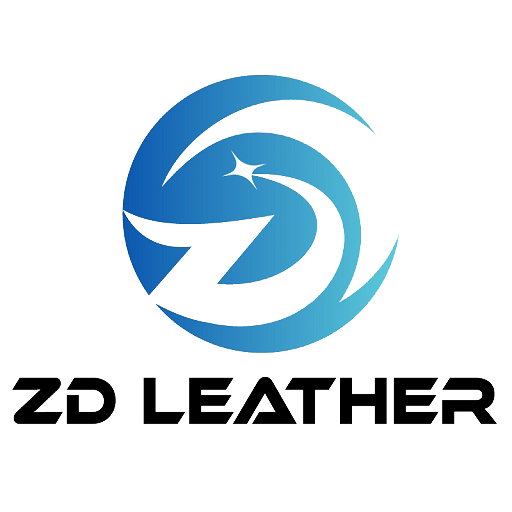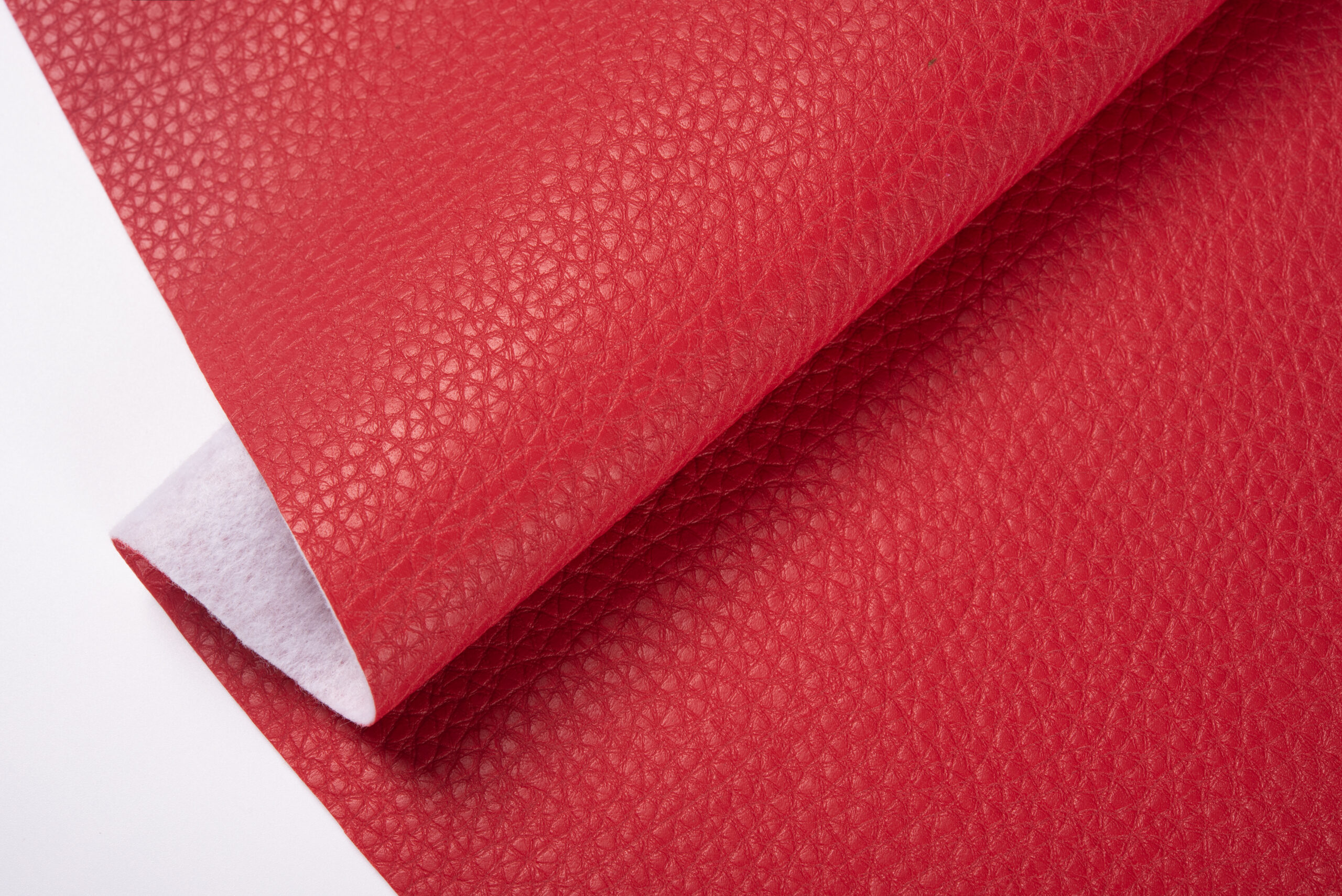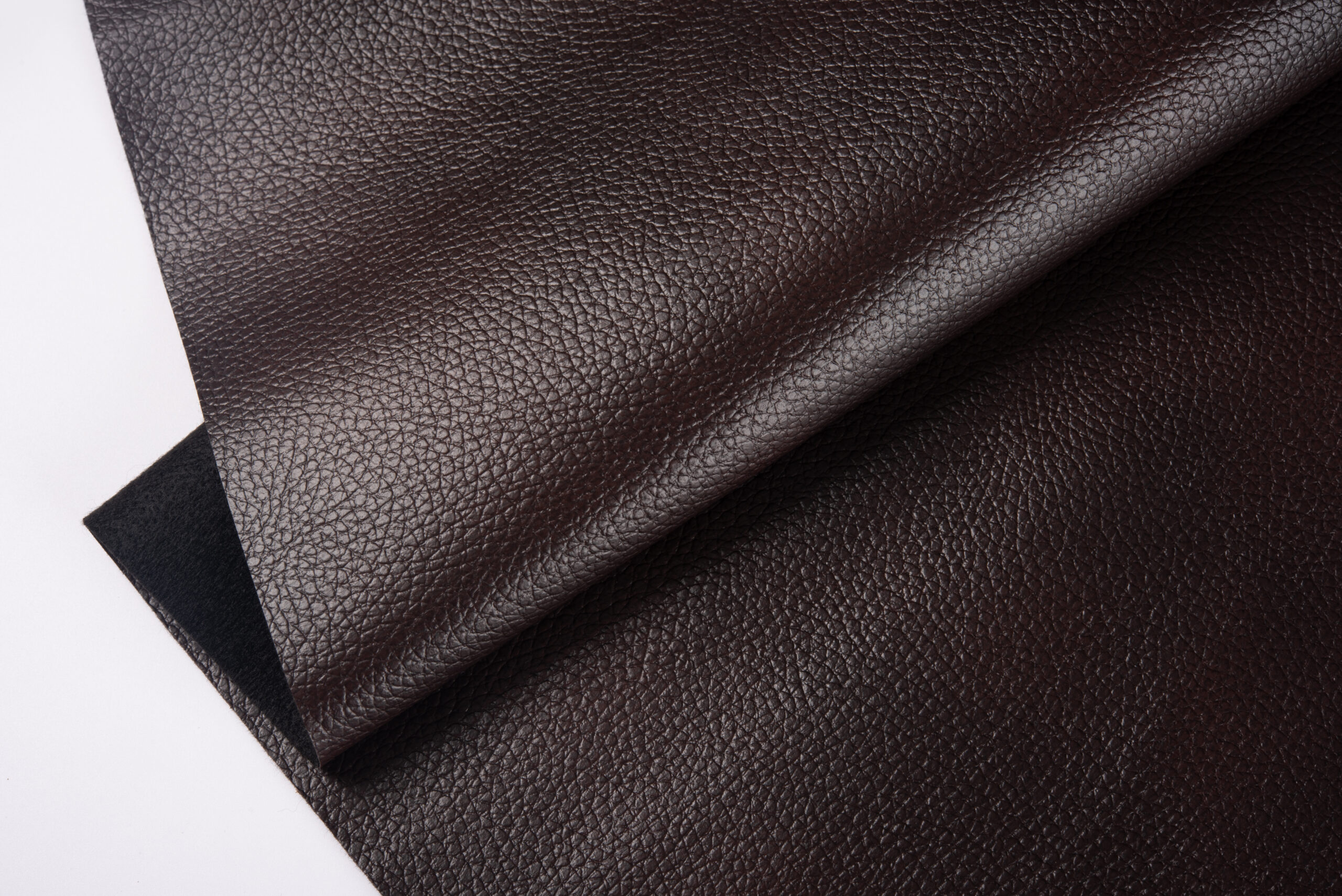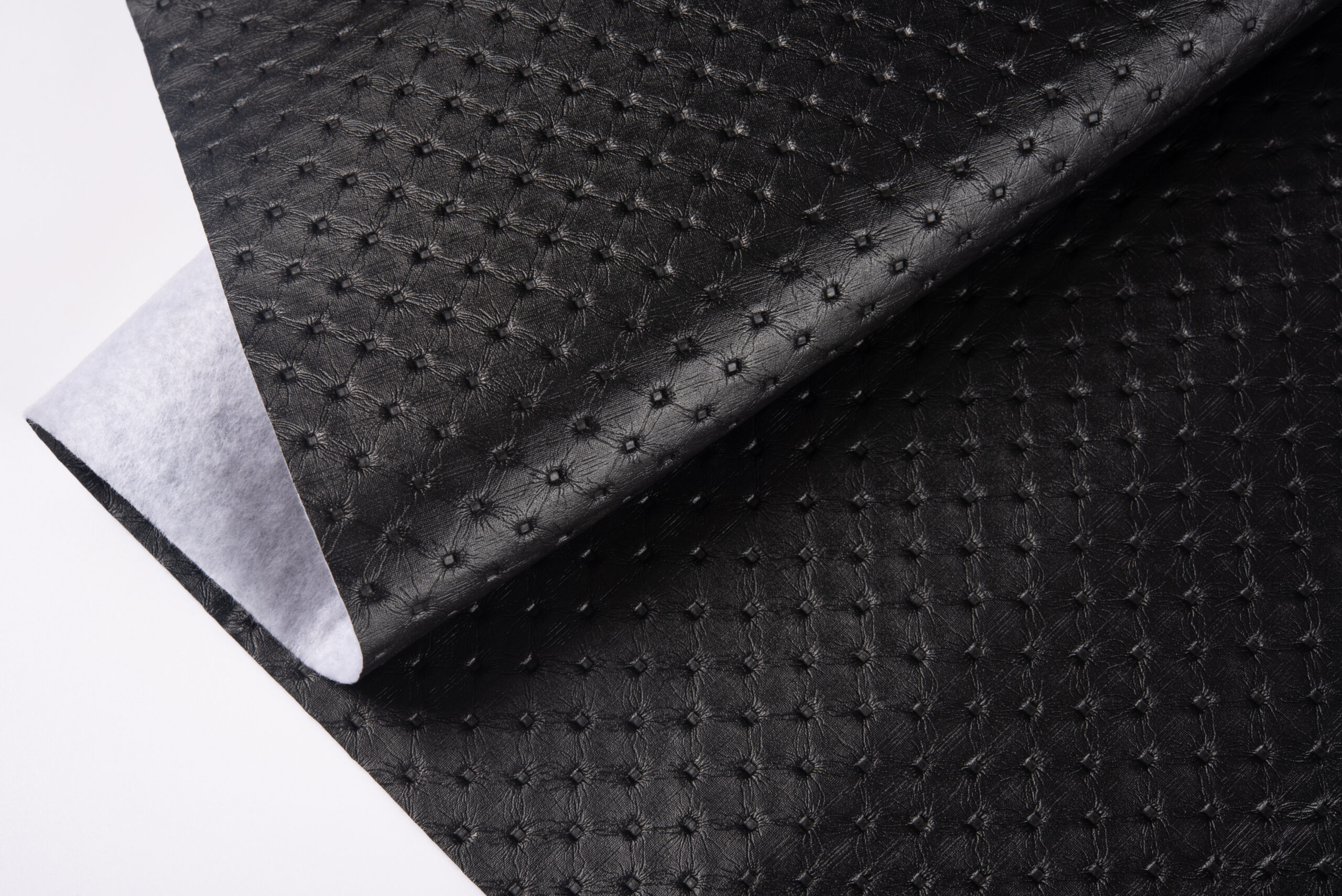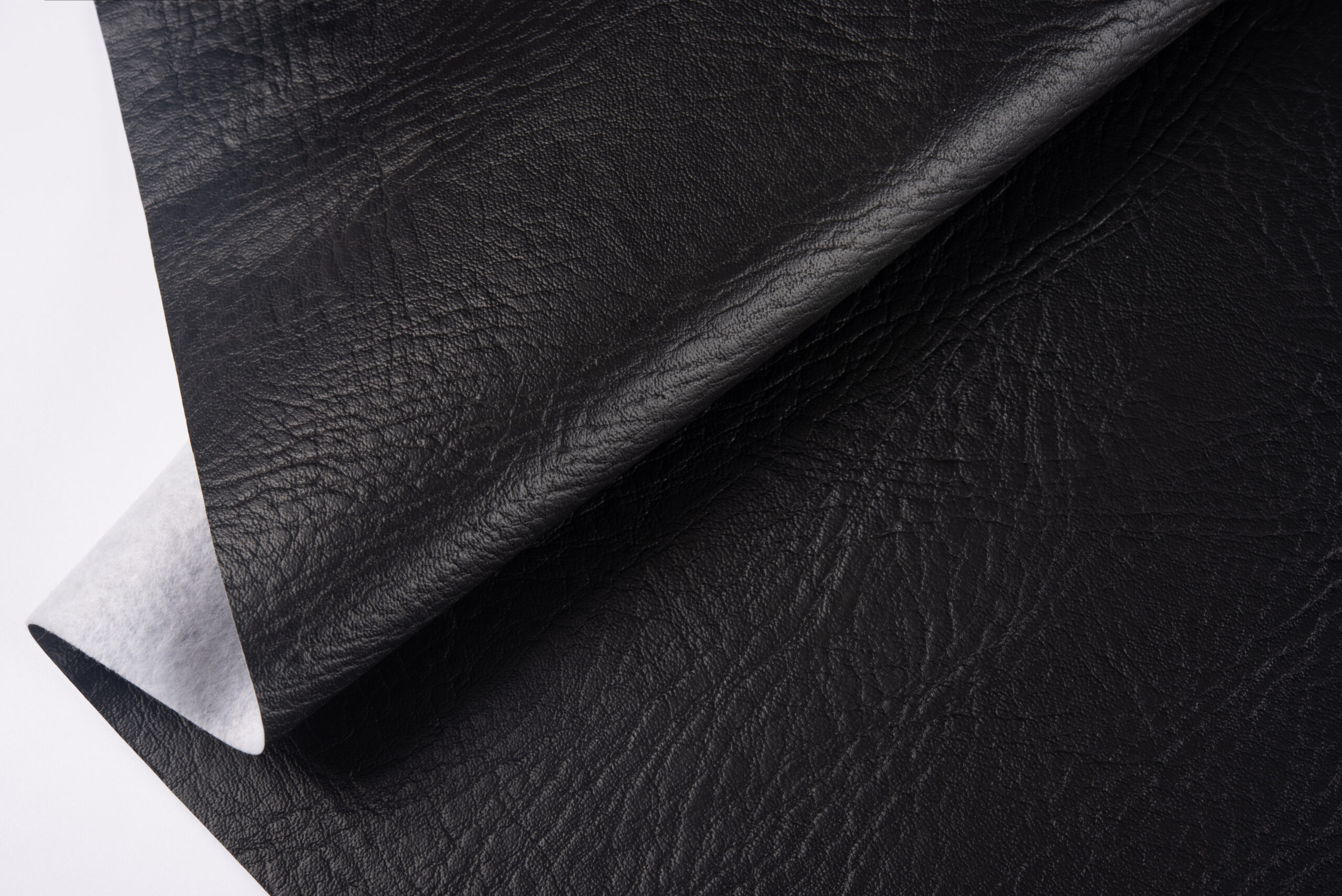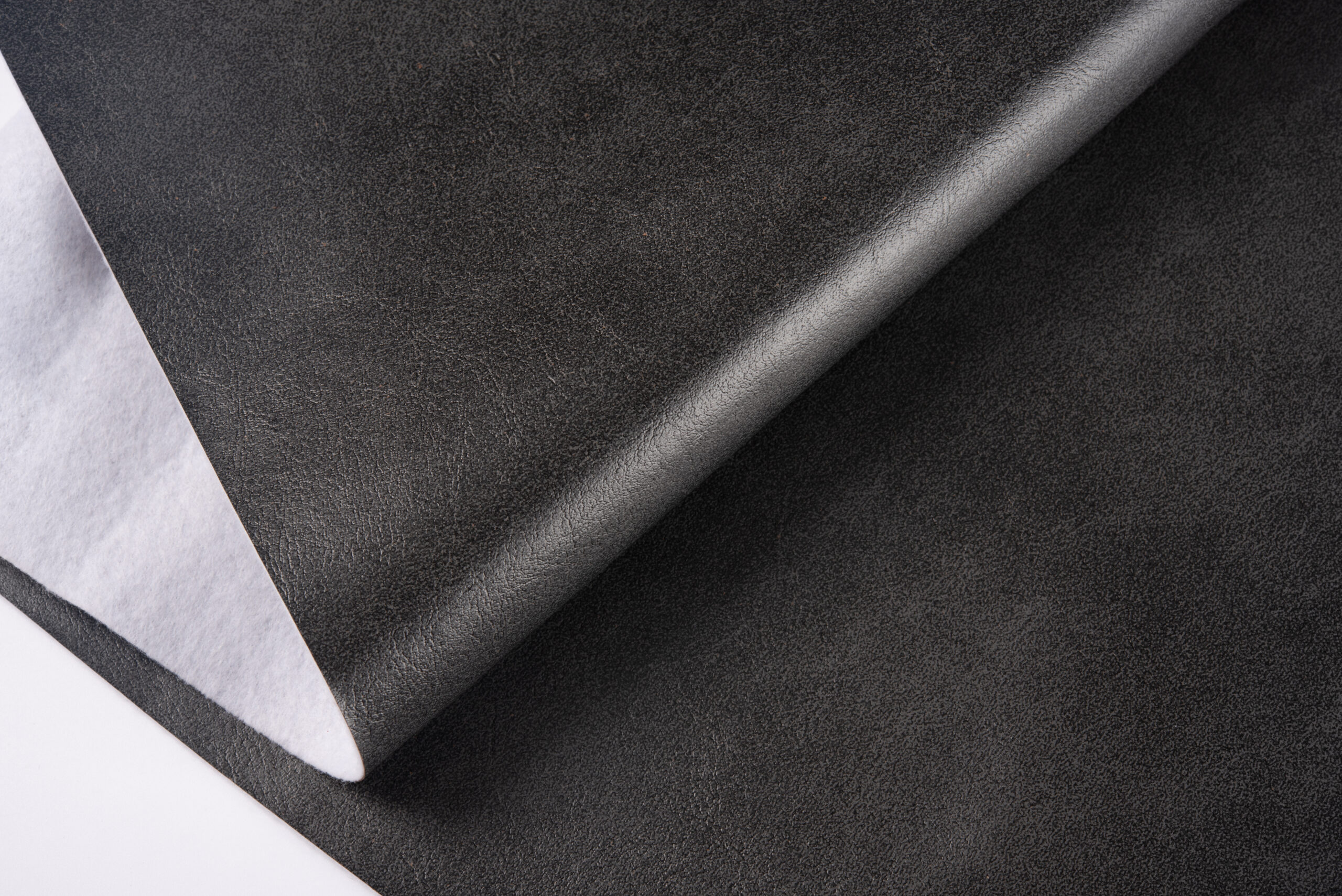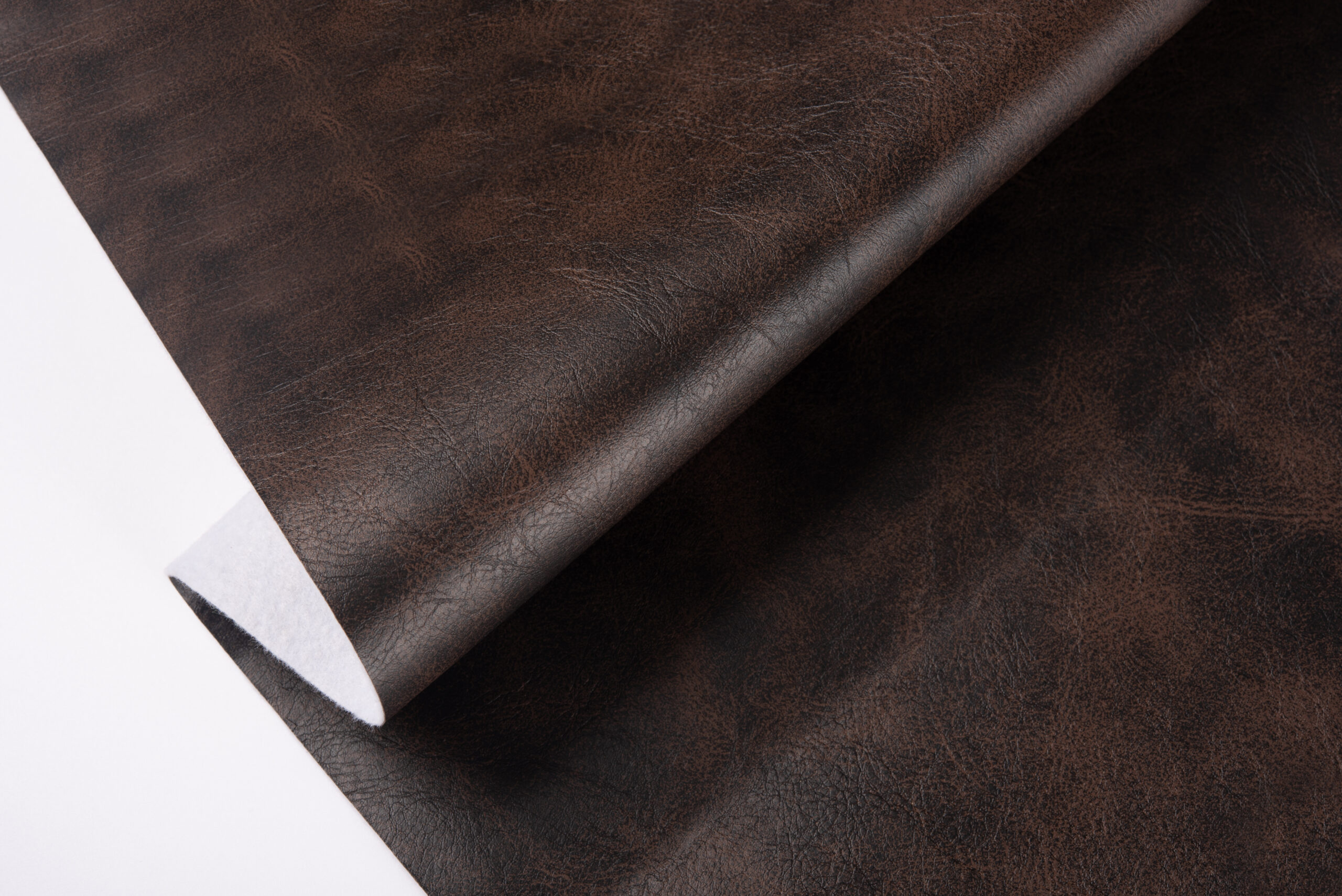Products
ZD Leather is a specialized manufacturer and exporter of artificial leather. Whether it’s product quality or innovation, we can provide solutions that meet your needs.
Custom Colors, Perfect Match – Tailor-Made Artificial Leather for You
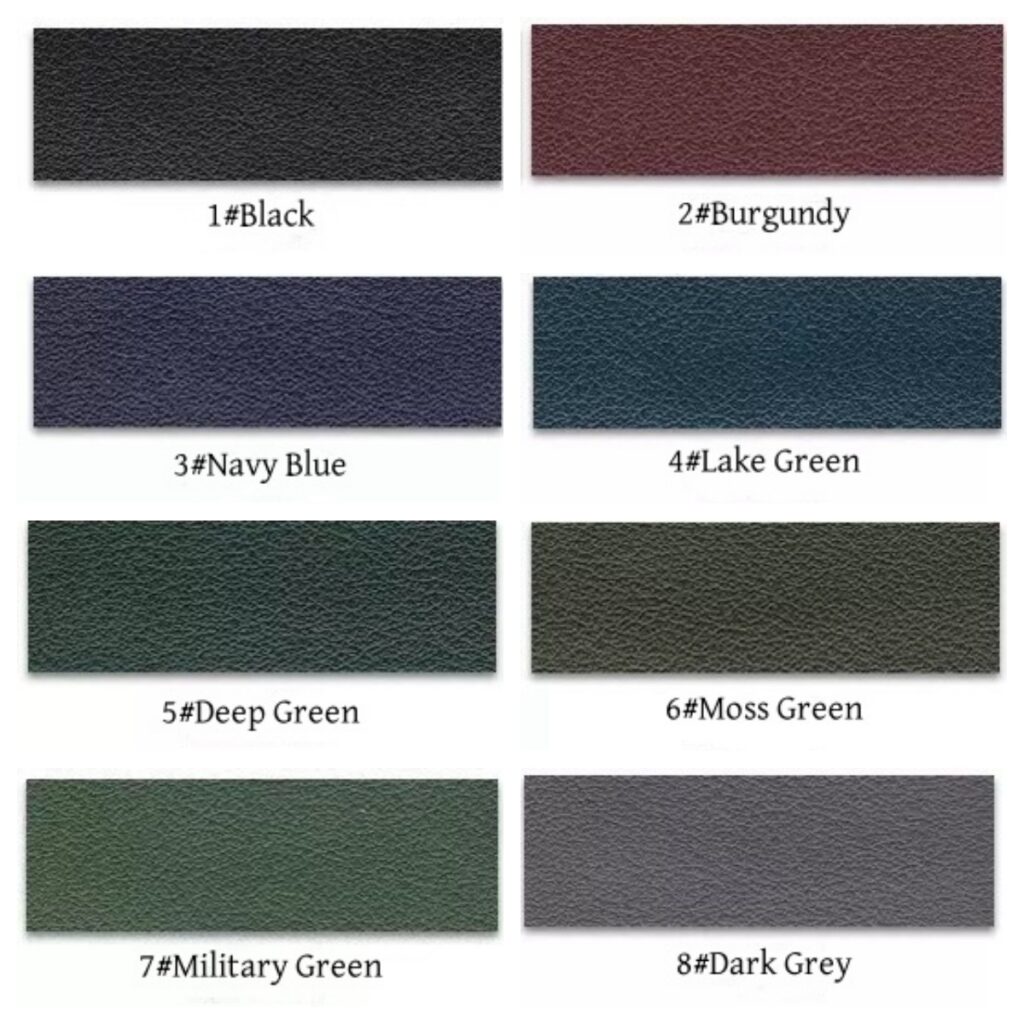
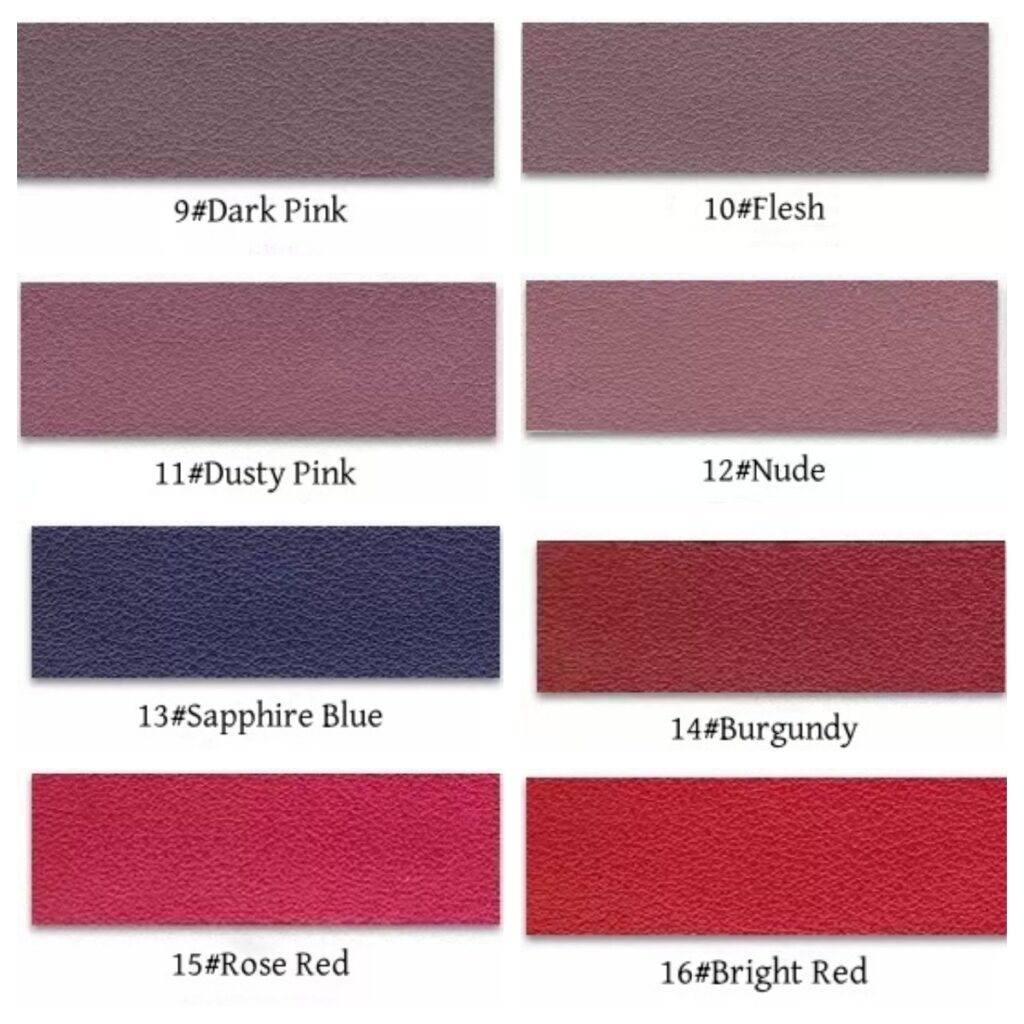
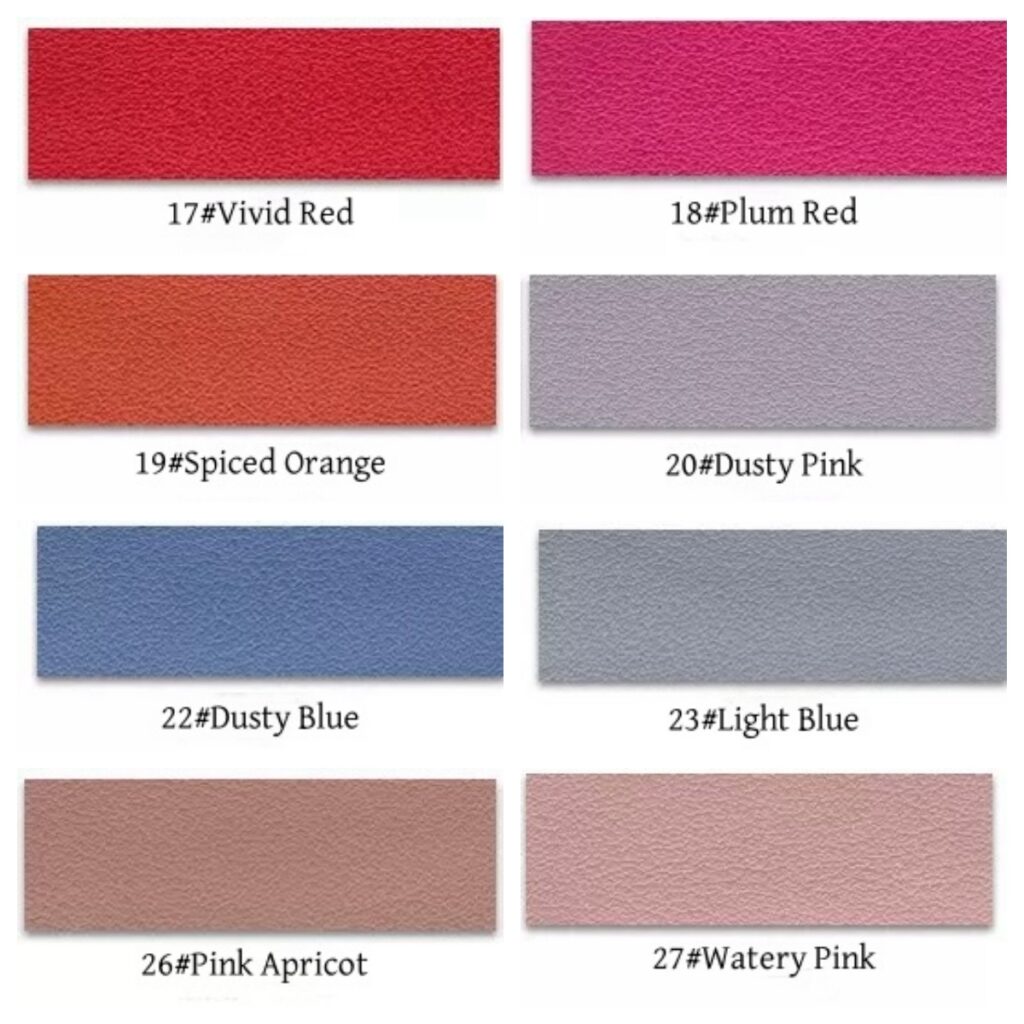
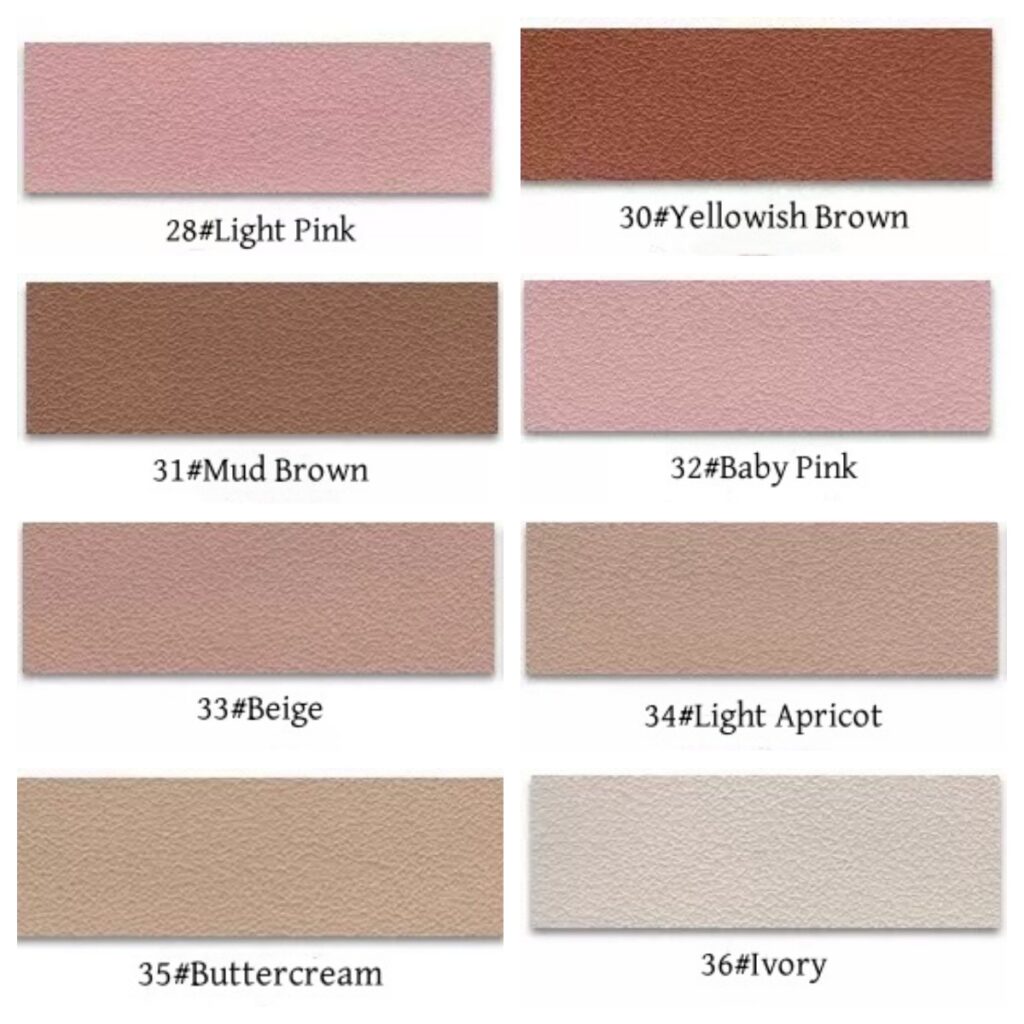
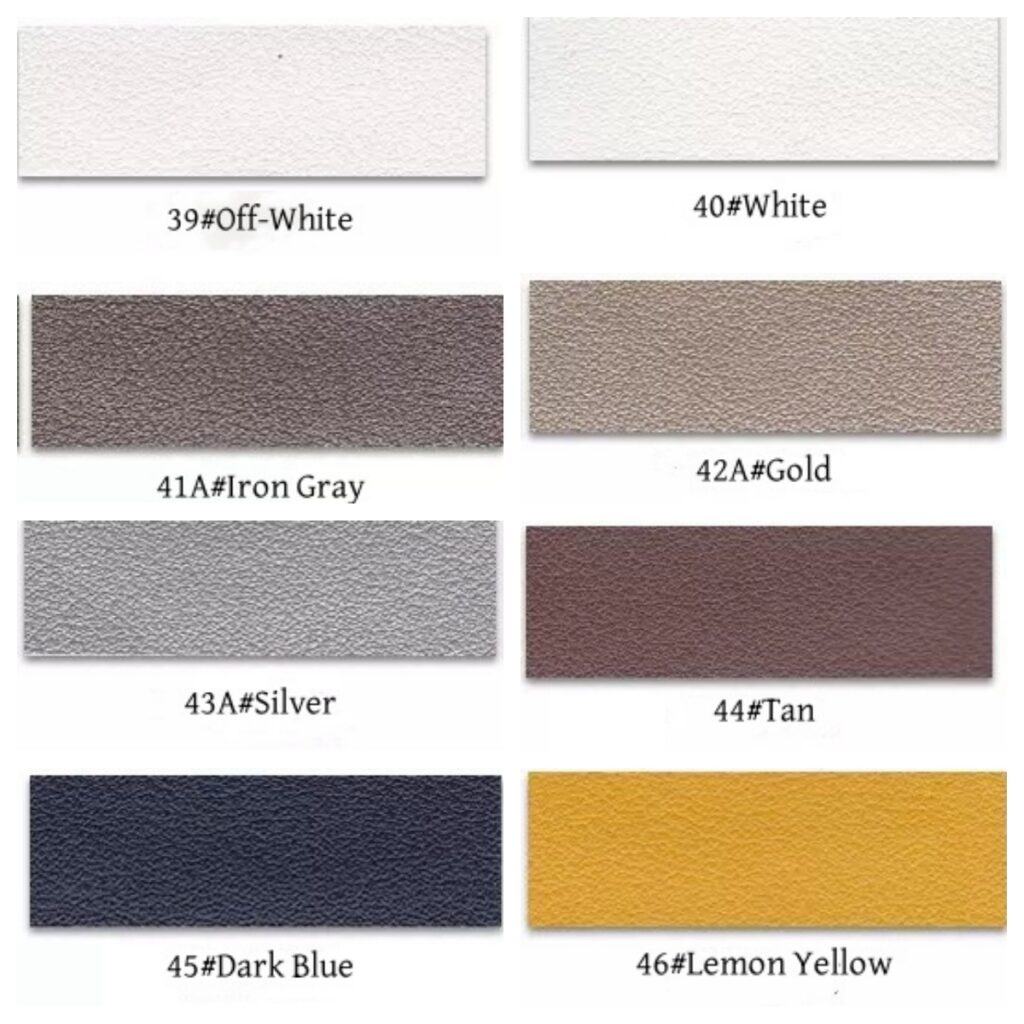
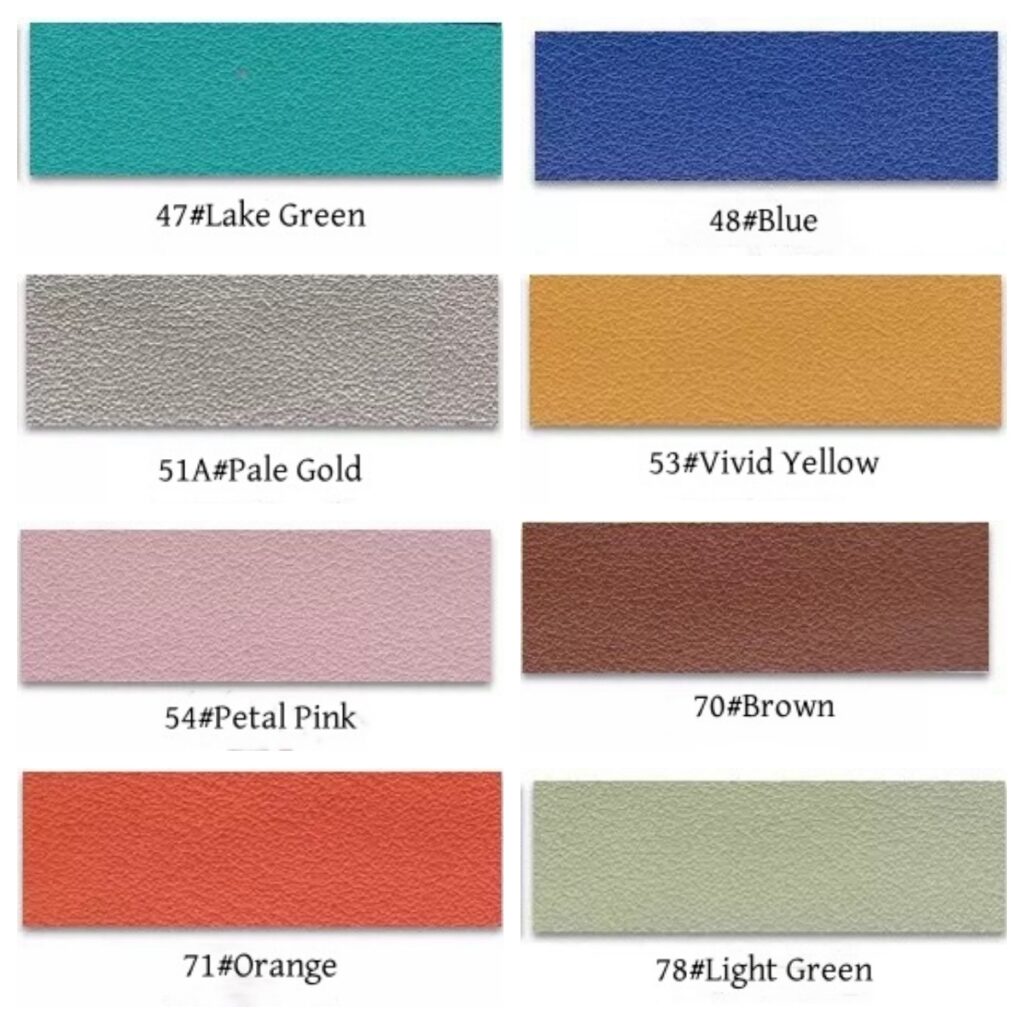
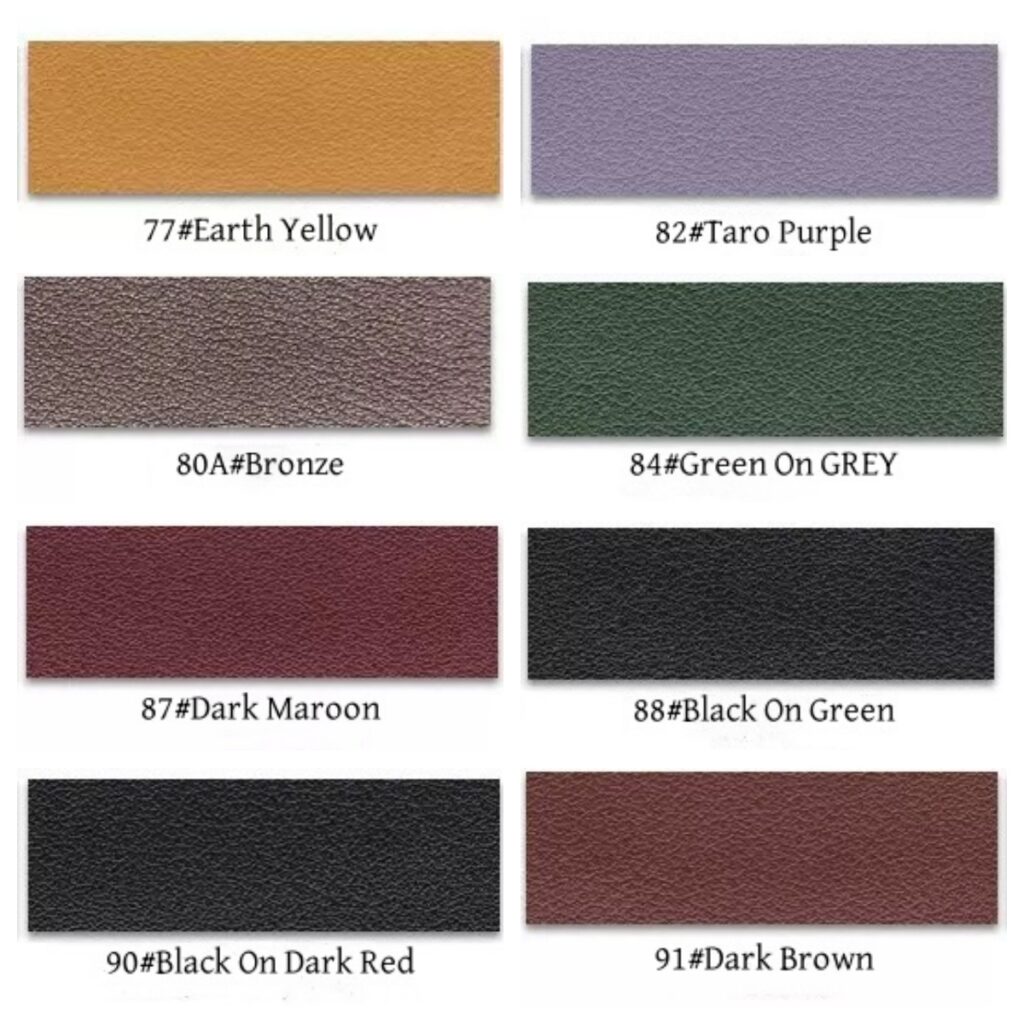
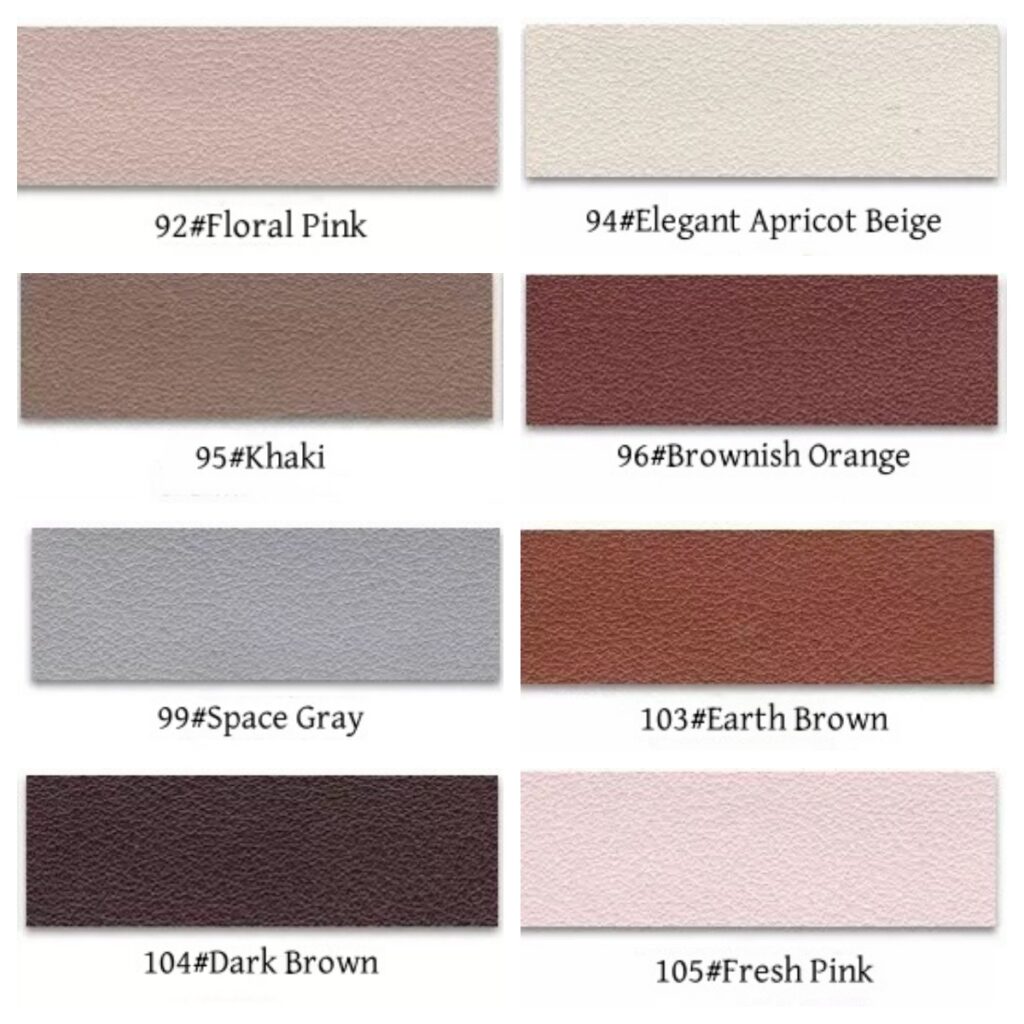
Premium Service: Perfectly Matched to Your Genuine Leather
Send us your genuine leather sample, and we’ll do more than just replicate it—we’ll meticulously recreate its texture, color, and gloss using our advanced synthetic leather technology. Our team of experts pays close attention to every detail, ensuring that every nuance of your sample is carefully matched with precision and care. From the grain to the sheen, nothing is overlooked in our process.
Our leather offers the same high-quality look, feel, and durability as genuine leather, making it ideal for a seamless integration into your products. Whether it’s for furniture, automotive interiors, or fashion accessories, you can trust us to deliver a professional, accurate match that meets your exact specifications. With us, you get more than just a product—you get a tailored solution that enhances the authenticity and quality of your brand.

The Selection Of Quality Specifications For Artificial Leather
When selecting quality specifications for artificial leather, several factors need to be considered. Firstly, the intended use of the product and the desired performance requirements should be taken into account to determine the necessary specifications for physical properties, chemical properties, and environmental performance. Secondly, attention should be given to the appearance quality of the product, including requirements for color, texture, glossiness, and other aspects. Additionally, characteristics such as abrasion resistance, waterproofness, and flame resistance should also be considered. Lastly, the choice of appropriate quality specifications should also take into account factors such as cost and market demand to ensure the product can gain a competitive advantage in the market.
The thickness of artificial leather is also an important factor in determining the quality of the product. Typically, we recommend a thickness not less than 0.7mm for synthetic leather with non-woven fabric as the base. Common thickness options include0.7mm, 0.8mm, 1.0mm, 1.2mm, 1.4mm, and 1.6mm. Thicker materials generally offer better durability, but conversely, they may result in a poorer tactile sensation. Therefore, options around 0.8mm or 1.0mm are more commonly chosen.Talk to us, we’ll provide you with the most professional advice.
The Ultimate Guide of Synthetic Leather
Base,Types, Uses and More
Table of Contents
Chpter1
Request A Free Quote
We'd like to work with you
Send us a message if you have any questions or request a quote.We will give you a reply whithin 24 hours.
+8613395755066
info@zdleatherco.com
What is Synthetic Leather?
Synthetic leather, also known as faux leather,artificial leather and fake leather,people in some countries also call it REXINE.It is a substitute for natural leather obtained by combining a synthetic resin with a substrate in a certain way (e.g. coating, laminating, etc.).
We are accustomed to differentiate artificial leather according to the type of surface resin: artificial leather produced with polyvinyl chloride (PVC) resin as a coating becomes PVC artificial leather. The artificial leather coated with polyurethane (PU) resin is called PU synthetic leather, and the artificial leather with PVC resin as the base layer and PU resin as the top layer is called semi-PU.
PVC leather is a synthetic material produced by applying a polyvinyl chloride (PVC) coating to a fabric substrate, which can be either woven or non-woven. This process involves blending PVC resin with plasticizers, stabilizers, and other additives to achieve the desired flexibility and durability. The result is a material that closely replicates the look and feel of genuine leather.One of the key advantages of PVC leather is its water resistance and durability, making it suitable for various industries, including furniture, automotive interiors, and fashion accessories.
PU leather, or polyurethane leather, is another synthetic alternative to genuine leather, created by coating a fabric base with polyurethane. Unlike PVC leather, PU leather is softer, more breathable, and offers a closer imitation of genuine leather’s luxurious feel. However, it’s less durable and more prone to wear, making it suitable for fashion items, accessories, and indoor furniture.
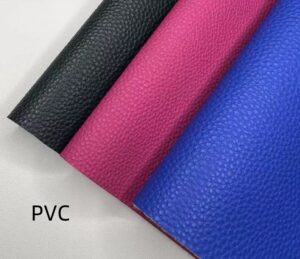
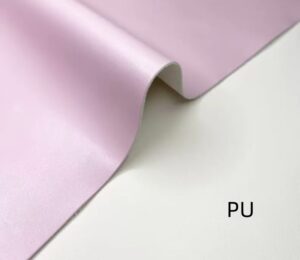
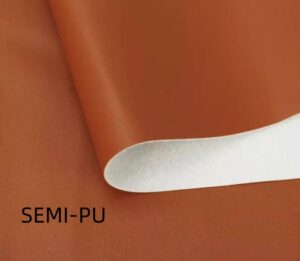
Chpter2
Advantages of Synthetic Leather Over Genuine Leather
When discussing the advantages of synthetic leather over genuine leather, there are several key aspects that make synthetic leather stand out, especially from a practical, economic, and environmental perspective:
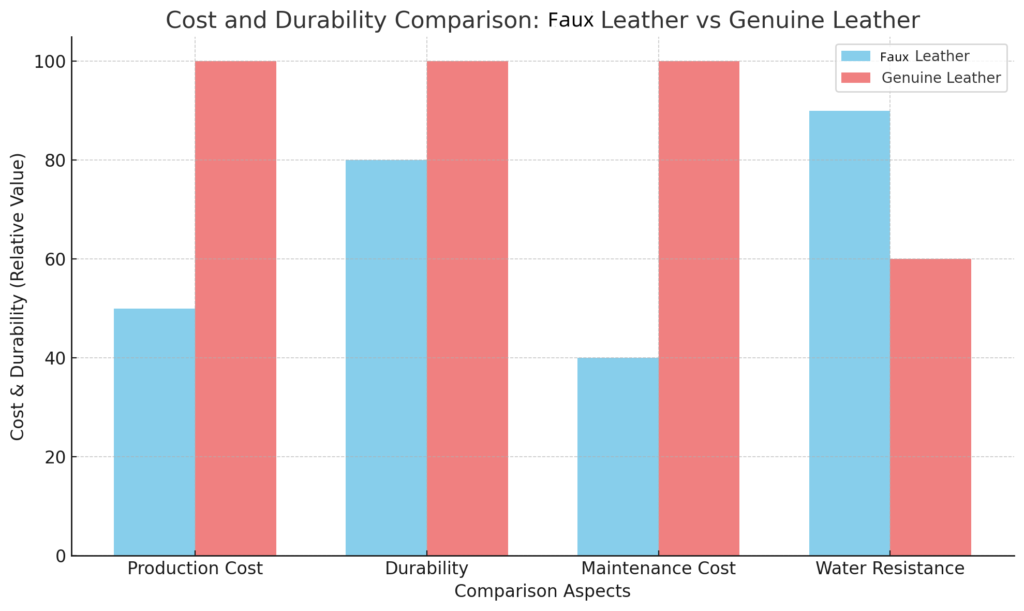
1. Cost-Effectiveness
Synthetic leather is significantly more affordable than genuine leather, largely due to lower material and production costs. Genuine leather requires extensive processing, including tanning and finishing, which increases its price. In contrast, synthetic leather is made using synthetic processes that are less labor-intensive and more scalable, allowing for mass production at a much lower cost. This makes synthetic leather an ideal choice for businesses and manufacturers seeking cost-efficient alternatives without compromising on appearance.
2. Durability and Maintenance
While genuine leather is known for its longevity, it requires careful maintenance to retain its quality. It is susceptible to staining, cracking, and wear if not properly cared for. synthetic leather, on the other hand, is much easier to maintain and is highly resistant to moisture, stains, and scratches. It doesn’t require regular conditioning like real leather does, making it a low-maintenance option for consumers and manufacturers alike. This durability makes it especially useful for high-traffic environments, such as automotive interiors and furniture.
3. Water Resistance
One of the most notable advantages of synthetic leather is its water resistance. Unlike genuine leather, which can absorb moisture and become damaged over time, synthetic leather is inherently waterproof due to its synthetic structure. This makes it ideal for products that are frequently exposed to moisture, such as outdoor furniture, car seats, and marine applications. The waterproof nature of synthetic leather also makes it more resistant to mildew and rot, giving it a longer lifespan in damp or humid conditions.
4. Versatility in Design and Customization
Synthetic leather offers greater versatility when it comes to design and customization. It can be produced in a wide range of colors, textures, and finishes, including those that closely mimic the look and feel of genuine leather. Additionally, manufacturers can easily tailor synthetic leather to specific customer requirements, such as embossing patterns or applying finishes that enhance its durability or aesthetic appeal. This flexibility in production allows synthetic leather to be used across a variety of industries, from fashion to automotive.
5. Environmental Considerations
While synthetic materials like PVC have traditionally been criticized for their environmental impact, advancements in PVC production technology have made it a more sustainable alternative to genuine leather. The production of genuine leather involves animal farming and chemical-intensive tanning processes, which contribute to deforestation, greenhouse gas emissions, and water pollution. In contrast, synthetic leather can be produced without the use of animal products and in more controlled manufacturing environments, reducing the ecological footprint associated with leather production.
By highlighting these advantages, synthetic leather becomes an appealing alternative for customers looking for cost-effective, durable, water-resistant, and customizable options, particularly in industries that demand large volumes of synthetic materials.
Chpter3
The Versatility of Synthetic Leather: Unlocking Opportunities Across Industries
Synthetic leather has become a staple material in a wide range of industries due to its exceptional adaptability, affordability, and durability. Whether for functional or aesthetic purposes, it offers a flexible and cost-effective solution that rivals genuine leather. Below are the key sectors where synthetic leather shines:
1. Furniture Industry

In the world of furniture upholstery, synthetic leather has proven indispensable. It is commonly used in the production of sofas, chairs, and cushions, particularly in high-traffic environments like homes, offices, and public spaces. Its durability, water resistance, and ease of maintenance make it ideal for both residential and commercial settings. Additionally, PVC leather and PU leather can be customized to replicate the luxurious look of genuine leather, all while offering creative flexibility in color, texture, and finishes—but at a fraction of the cost.
2. Automotive Interiors
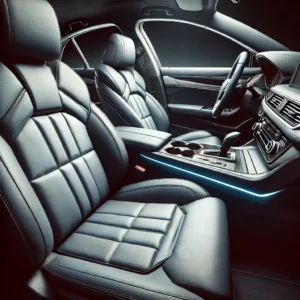
The automotive industry has embraced synthetic leather for its superior performance in vehicle interiors, including seat covers, door panels, and dashboard trims. Its wear-resistant and water-resistant properties ensure longevity in heavily used environments. PVC leather can endure exposure to sunlight and heat without cracking or fading, making it the preferred material for manufacturers focused on delivering quality and cost-efficiency in vehicle production.
3. Fashion Industry
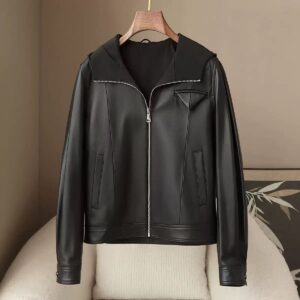 As sustainability and ethics become more prominent in the fashion world, PU leather has emerged as a top choice for producing bags, shoes, belts, and jackets. It provides a cruelty-free alternative to genuine leather, catering to the growing demand for eco-conscious products. The versatility of synthetic leather allows designers to explore bold colors, unique textures, and intricate patterns, creating standout pieces that are lightweight, durable, and fashion-forward.
As sustainability and ethics become more prominent in the fashion world, PU leather has emerged as a top choice for producing bags, shoes, belts, and jackets. It provides a cruelty-free alternative to genuine leather, catering to the growing demand for eco-conscious products. The versatility of synthetic leather allows designers to explore bold colors, unique textures, and intricate patterns, creating standout pieces that are lightweight, durable, and fashion-forward.
4. Bags and Accessories
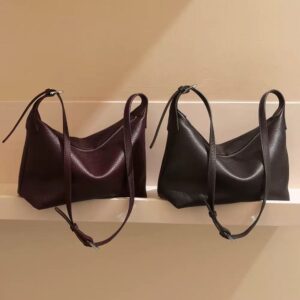
For manufacturers of handbags, backpacks, and wallets, synthetic leather offers the perfect balance between style and affordability. Its ability to mimic the luxurious look of genuine leather adds a premium touch, while its resistance to moisture and wear makes it ideal for everyday use. With low production costs and endless possibilities for customization in terms of patterns, colors, and finishes, synthetic leather has become the go-to material for affordable yet stylish accessories.
5. Upholstery
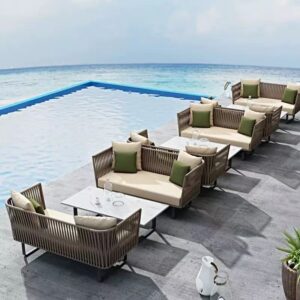 The marine, RV, and outdoor furniture sectors favor PVC leather for its high resistance to environmental elements such as water, UV rays, and humidity. Unlike genuine leather, which can be prone to deterioration in these conditions, PVC leather offers a practical and long-lasting solution. Its easy maintenance and durability make it a reliable choice for both indoor and outdoor upholstery applications.
The marine, RV, and outdoor furniture sectors favor PVC leather for its high resistance to environmental elements such as water, UV rays, and humidity. Unlike genuine leather, which can be prone to deterioration in these conditions, PVC leather offers a practical and long-lasting solution. Its easy maintenance and durability make it a reliable choice for both indoor and outdoor upholstery applications.
6. Medical and Hospitality Sectors
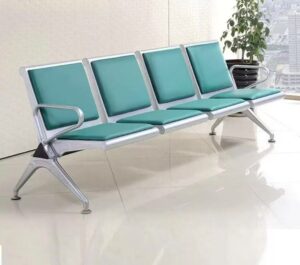
In healthcare and hospitality, hygiene is of utmost importance. synthetic leather excels in these sectors due to its easy-to-clean and disinfect properties, making it a practical material for medical furniture, hospital beds, and waiting room chairs. In restaurants and hotels, synthetic leather is often used for seating and décor, as it withstands frequent cleaning and heavy use while maintaining its comfort and appearance.
7. Sports and Recreation Equipment
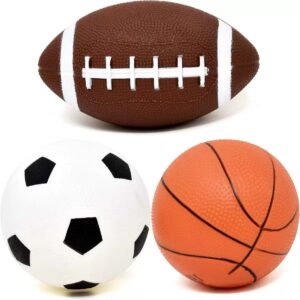
For sports equipment like boxing gloves, gym mats, and exercise benches, synthetic leather is the material of choice. Its abrasion resistance and flexibility ensure durability even under heavy use. Moreover, its waterproof properties make it suitable for outdoor recreational equipment, such as pool chairs and inflatable products, where constant exposure to water and the elements is a concern.
By illustrating its extensive range of applications, it’s clear that synthetic leather is a versatile and highly valued material across numerous industries. Its adaptability, coupled with its durability and affordability, makes it the preferred alternative to genuine leather, giving manufacturers and consumers alike a modern, practical solution that meets a variety of needs.
Chpter4
Customization Options: Tailoring Synthetic Leather to Your Needs
One of the most significant advantages of synthetic leather is its exceptional customization potential. Whether your goal is to achieve a specific look, texture, or functionality, PVC leather can be tailored to meet a wide range of design and performance requirements. This flexibility makes it an ideal material for diverse industries, from fashion to automotive to furniture manufacturing.
Here are the key areas of customization synthetic leather offers:

1. Variety of Textures
Synthetic leather can be produced in a multitude of textures, ranging from smooth and sleek finishes to intricate embossed patterns. Manufacturers can replicate the look and feel of natural leathers such as full-grain or nubuck leather, but they can also create more innovative textures like crocodile, snakeskin, or fabric-like grains. This variety ensures that synthetic leather can mimic the luxurious feel of genuine leather while also offering unique patterns that might not be achievable with traditional materials.
For example:
- Smooth textures: Ideal for fashion accessories, such as bags and shoes, where a polished appearance is needed.
- Embossed textures: Used in furniture upholstery and automotive interiors to provide depth and detail.
2. Extensive Color Range
Unlike genuine leather, which is often limited to earthy tones, synthetic leather offers a limitless array of colors. Manufacturers can produce bright, bold shades for trendy fashion applications or neutral and subdued tones for high-end furniture and automotive interiors. synthetic leather can also be dyed to exact Pantone or RAL color codes, ensuring precise brand consistency for businesses or specific design preferences for individuals.
This extensive color palette enables synthetic leather to fit into any design scheme, making it a favorite in industries like:
- Fashion: Designers can experiment with vibrant colors for seasonal collections.
- Furniture: Interior designers can choose subtle, neutral tones for a minimalist look.
3. Innovative Patterns and Designs

The design possibilities with synthetic leather are virtually endless. Manufacturers can imprint custom patterns, create geometric designs, or incorporate company logos directly onto the material. This level of customization is particularly appealing to businesses looking for branded products or unique, eye-catching designs that stand out in the market.
Additionally, advanced techniques like laser-cutting can create intricate patterns, offering even more creative options for industries like:
- Luxury goods: Custom patterns for high-end bags and wallets.
- Corporate furniture: Branded seating or upholstery with logos or specific design elements.
4. Range of Finishes
Synthetic leather comes in a variety of finishes, which can dramatically alter its appearance and performance:
- Matte finish: Provides a sophisticated, understated look, perfect for formal applications such as office furniture or corporate interiors.
- Glossy finish: Ideal for creating a luxurious, high-end feel, often used in automotive interiors or fashion accessories.
- Metallic finishes: Offer a bold, modern look, frequently used in footwear or fashion handbags.
The choice of finish can also influence the material’s functional properties, such as water resistance or scratch resistance, depending on the application.
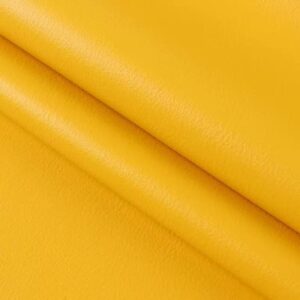
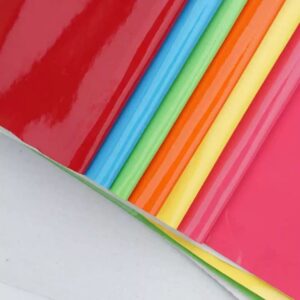
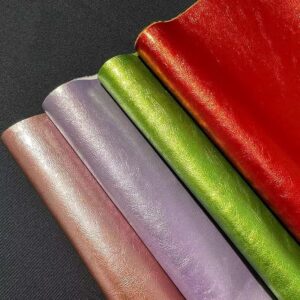
5. Functional Customizations
Beyond appearance, synthetic leather can be engineered to meet specific performance requirements:
- Fire resistance: For applications in sectors such as aviation, automotive, and hospitality, where safety standards are a priority.
- Waterproofing: Essential for outdoor furniture, marine uses, or sports equipment.
- UV resistance: Ensures durability and color retention when used in environments with heavy sun exposure, such as outdoor upholstery or convertible car interiors.
Functional customization allows businesses to choose a product that fits both their aesthetic needs and performance expectations, ensuring long-lasting quality in any setting.
synthetic leather’s customization options allow it to be adapted to meet specific industry needs, offering unmatched design flexibility, aesthetic appeal, and functional versatility. Whether it’s the creation of unique textures, custom colors, intricate patterns, or specialized finishes, synthetic leather can be tailored to meet both design specifications and practical applications, providing a superior alternative to traditional materials. This customization makes it an increasingly popular choice in industries ranging from fashion and furniture to automotive and sports equipment.
Chpter5
Durability and Maintenance: The Strengths of PVC Leather
PVC leather is widely recognized for its durability and low-maintenance nature, making it an ideal material for a wide range of applications. Whether used in furniture, automotive interiors, fashion items, or outdoor equipment, PVC leather offers exceptional toughness and ease of care, providing long-lasting performance with minimal upkeep. Below is an in-depth look at how durability and maintenance contribute to the material’s appeal:
1. Toughness and Longevity
Resistant to Wear and Tear: PVC leather is known for its high resistance to daily wear and tear, making it suitable for environments that experience frequent use. Unlike genuine leather, which can develop cracks or fade over time, PVC leather is designed to withstand abrasion, scratches, and scuffs, retaining its appearance even after prolonged use.
Water and Stain Resistance: One of the key features of PVC leather is its waterproof nature. The PVC coating creates a barrier that prevents moisture from seeping into the fabric, making it an excellent choice for applications like automotive interiors, outdoor furniture, and fashion accessories. This resistance to moisture also protects the material from stains and mildew, which are common issues with natural leather.
UV and Heat Resistance: PVC leather is formulated to resist UV rays and heat exposure, which helps it retain its color and texture in sun-exposed or high-temperature environments. This makes it a popular material for convertible car interiors, marine upholstery, and outdoor furniture, as it can withstand harsh outdoor conditions without fading or deteriorating.
Fire Resistance: PVC leather’s flame-retardant properties make it a safer choice for environments that require adherence to stringent fire safety regulations. For instance, in the automotive, aviation, and hospitality industries, where fire resistance is crucial, PVC leather ensures both safety and durability.
2. Ease of Maintenance
Low Maintenance Requirements: One of the primary advantages of PVC leather is its minimal maintenance requirements. In contrast to genuine leather, which requires regular conditioning to prevent drying and cracking, PVC leather needs only basic care to maintain its appearance. Simple cleaning with a damp cloth or mild soap solution is usually sufficient to remove dirt and debris.
Stain Resistance: Thanks to its non-porous surface, PVC leather is inherently resistant to stains. Unlike natural leather, which can absorb liquids and oils, PVC leather allows spills to be wiped away easily, without leaving any permanent marks. This makes it an excellent choice for environments where spills are common, such as in restaurants, hotels, or automotive interiors.
Easy to Clean: PVC leather is easy to clean and disinfect, which is especially important in settings where hygiene is a top priority, such as hospitals, clinics, and public spaces. Its smooth surface can be wiped down with disinfectants without the risk of damaging the material, making it suitable for medical furniture and waiting room seating.
No Need for Special Conditioners: While natural leather requires specialized conditioners and treatments to maintain its softness and prevent drying, PVC leather doesn’t require such intensive care. Leather conditioners are typically formulated for porous materials like genuine leather, but they can damage PVC leather’s synthetic surface. Instead, gentle cleaning with standard household products will suffice to preserve its appearance and feel.
3. Long-Term Performance
Consistent Appearance: Over time, genuine leather may develop a patina, which some find desirable, but this also means the leather’s appearance changes and can show signs of aging. PVC leather, however, maintains a consistent look throughout its lifespan, providing a reliable option for those who prefer a material that retains its original aesthetic over many years.
Longevity: PVC leather generally lasts 8 to 10 years, and high-quality versions can even last longer. Its ability to withstand environmental factors such as humidity, sunlight, and abrasion ensures it maintains its integrity and aesthetic appeal for a longer period than some other materials. For products like automotive seats, furniture, or handbags, this longevity offers great value and cost-effectiveness.
Environmental Durability: For outdoor applications, PVC leather performs particularly well due to its resistance to harsh environmental factors like rain, sun, and wind. In industries such as marine upholstery or outdoor furniture, the material’s ability to endure prolonged exposure to the elements makes it a reliable and durable choice.
PVC leather’s durability and ease of maintenance are some of its most significant advantages, making it a practical and cost-effective alternative to genuine leather. Its ability to withstand daily wear, environmental exposure, and regular cleaning ensures that it provides long-lasting performance across various industries, from fashion to furniture to automotive. By choosing PVC leather, consumers and manufacturers alike can benefit from a material that is both tough and easy to care for, ensuring products that stay looking good for years to come.
Chpter6
Environmental Impact: The Eco-Friendly Aspects of Synthetic Leather
As consumers and industries increasingly focus on sustainability and ethical products, the environmental impact of materials plays a critical role in purchasing decisions. synthetic leather, while synthetic, offers several eco-friendly advantages over genuine leather, particularly in terms of reducing animal exploitation, lowering resource consumption, and evolving toward more sustainable production methods. Here’s an in-depth look at the environmental benefits of synthetic leather:
1. No Animal Exploitation
Cruelty-Free Alternative: One of the primary eco-friendly aspects of synthetic leather is that it serves as a cruelty-free alternative to genuine leather. Traditional leather is made from animal hides, primarily from cattle, and the leather industry is closely linked to the meat industry, contributing to the farming and slaughtering of animals. In contrast, synthetic leather is entirely synthetic, meaning no animals are harmed or used in its production. For environmentally conscious consumers and brands committed to animal welfare, synthetic leather offers an attractive option that aligns with their values.
Supporting Vegan Products: As the demand for vegan and plant-based products rises, many fashion, furniture, and automotive companies are turning to synthetic alternatives like synthetic leather. This material provides a way for businesses to offer animal-free products, catering to the growing market of consumers who prefer ethical, cruelty-free solutions in their lifestyle choices.
2. Reduced Resource Consumption
Water Conservation: Leather tanning, which transforms raw animal hides into usable leather, is a water-intensive process. It involves soaking hides in large quantities of water, which contributes to water waste and the pollution of natural water sources. Additionally, the raising of livestock for hides requires a significant amount of water. In contrast, the production of synthetic leather uses far less water, making it a more environmentally responsible alternative. This is especially important in regions where water scarcity is a pressing issue.
Lower Energy Usage: The production process for genuine leather also involves significant energy consumption, particularly in the phases of tanning, drying, and finishing. synthetic leather, on the other hand, is produced through chemical synthesis, which typically requires less energy than traditional leather processing. Moreover, innovations in synthetic leather manufacturing are continuously working to reduce the carbon footprint by improving energy efficiency in production plants.
3. Sustainable Manufacturing Practices
Phasing Out Harmful Chemicals: Historically, the production of synthetic leather involved the use of phthalates and other potentially harmful chemicals as plasticizers. However, modern manufacturing practices are increasingly moving toward phthalate-free alternatives and other non-toxic plasticizers. These newer production methods minimize the release of hazardous substances, both during the manufacturing process and throughout the life cycle of the product. This shift makes synthetic leather a safer and more sustainable option for industries such as fashion and automotive.
Recyclability and Circular Economy: Many manufacturers are now producing recyclable synthetic leather, which aligns with the principles of the circular economy. Instead of discarding used synthetic leather products, they can be recycled and reprocessed into new materials, thereby reducing the amount of waste that ends up in landfills. This focus on recyclability not only extends the lifespan of synthetic leather but also contributes to waste reduction and resource conservation.
Reduction of Emissions: The livestock industry, which supplies hides for genuine leather, is a major contributor to greenhouse gas emissions, particularly methane and carbon dioxide. By opting for synthetic leather, which is produced in controlled environments, emissions associated with animal farming are significantly reduced. Additionally, ongoing improvements in synthetic leather production aim to further lower emissions by utilizing renewable energy sources and energy-efficient processes.
4. Longevity and Waste Reduction
Durability Reduces Waste: synthetic leather’s durability is an environmentally beneficial attribute, as longer-lasting products mean less frequent replacements. By choosing a material that maintains its integrity and appearance over time, manufacturers and consumers reduce the overall demand for new products. This results in less waste generation and minimizes the environmental impact associated with producing and disposing of goods.
Lower Demand for Land and Resources: Unlike genuine leather, which requires land and resources for animal farming, synthetic leather production is independent of agricultural constraints. This reduces the strain on land use, deforestation, and the resources needed to maintain livestock. By shifting to synthetic alternatives like synthetic leather, industries can decrease the environmental pressures associated with land-based resource consumption.
5. Alignment with Ethical and Sustainable Brands
Appealing to Eco-Conscious Consumers: For companies that prioritize sustainability and ethical sourcing, synthetic leather offers a material that aligns with their goals. As consumers become more environmentally aware, they are increasingly seeking products that reflect their commitment to reducing their carbon footprint, minimizing waste, and avoiding animal-derived materials. synthetic leather provides an opportunity for brands to meet this growing demand while offering a high-quality, versatile alternative to genuine leather.
Corporate Responsibility and Green Certification: Many companies that manufacture or use synthetic leather are adopting green certifications and adhering to international environmental standards such as REACH (Registration, Evaluation, Authorization, and Restriction of Chemicals) in the EU and RoHS (Restriction of Hazardous Substances). By ensuring that their PVC leather products meet these standards, businesses can enhance their corporate responsibility credentials and appeal to eco-conscious customers.
Synthetic leather, while synthetic, offers several environmental advantages over genuine leather, particularly in terms of animal welfare, resource conservation, and sustainable manufacturing. As the demand for ethical, eco-friendly products grows, synthetic leather stands out as a versatile and sustainable alternative that aligns with modern consumers’ values. With improvements in recyclability, reduced emissions, and non-toxic production methods, synthetic leather continues to evolve as a material that supports both business innovation and environmental responsibility.
Chpter7
Comparison Between PVC And PU Leather: Choosing the Right Synthetic Leather
When deciding between PVC leather and PU leather, it’s essential to consider their differences in durability, water resistance, flexibility, and specific use cases. Both materials offer excellent alternatives to genuine leather, but they excel in different areas depending on the application. Below is a detailed comparison to help customers make an informed decision on which synthetic leather best suits their needs.
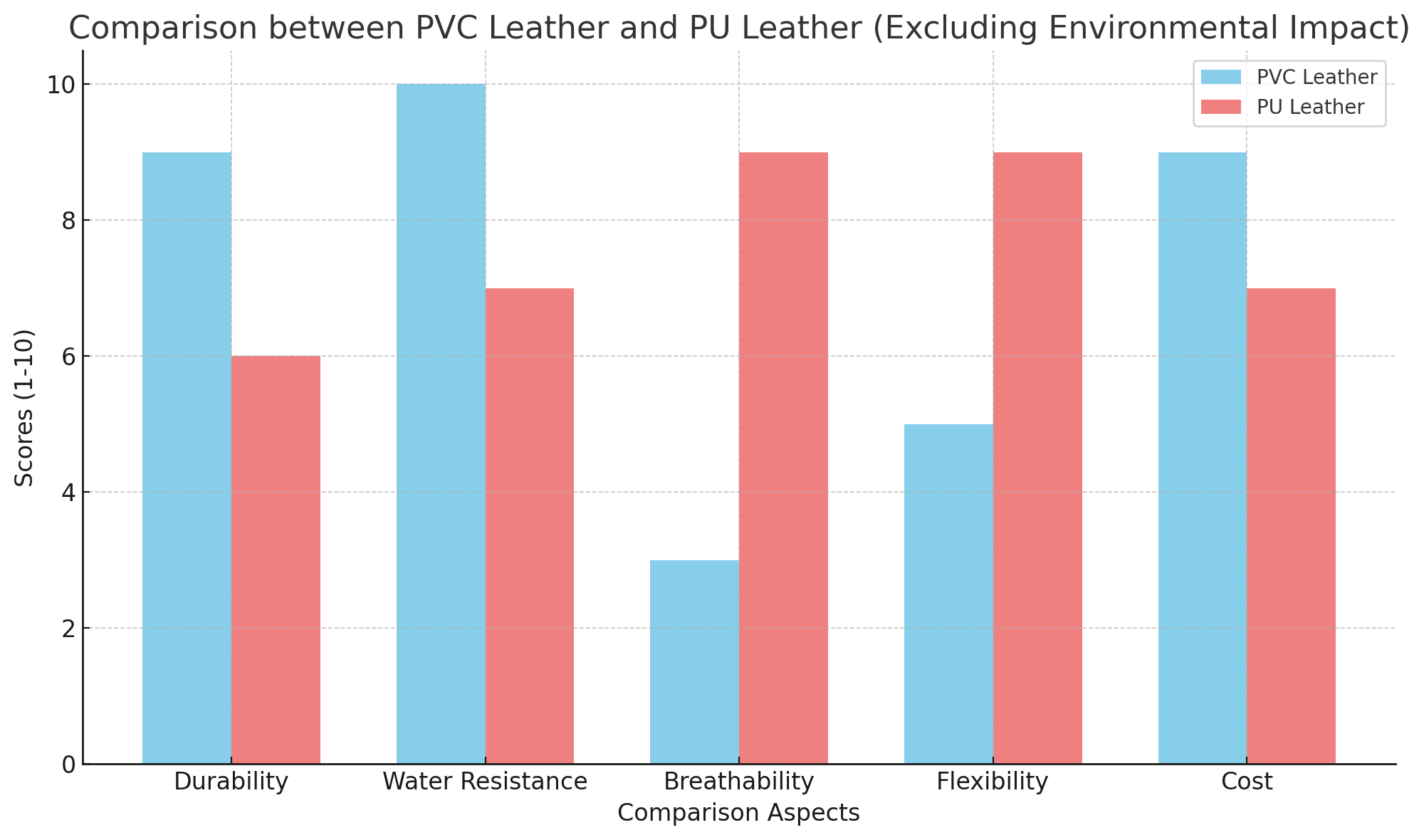
1. Durability
PVC Leather: Known for its toughness and resistance to wear, PVC leather is more durable in high-traffic environments. It is engineered to withstand scratches, abrasions, and tears, making it ideal for applications that require long-term performance. This makes PVC leather a popular choice in automotive interiors, furniture upholstery, and outdoor products, where durability is critical.
PU Leather: While PU leather is softer and more flexible, it tends to be less durable than PVC leather. PU leather is prone to cracking and peeling over time, especially in high-wear areas. It is best suited for items that don’t undergo heavy use or constant friction, such as fashion accessories or light-use furniture. Despite its lower durability compared to PVC, PU leather offers an attractive soft touch and comfort, which is beneficial for specific applications.
2. Water Resistance
PVC Leather: One of the key strengths of PVC leather is its excellent water resistance. The PVC coating creates a protective layer that makes the material waterproof, making it ideal for products exposed to moisture or outdoor conditions. PVC leather is commonly used in environments where waterproofing is a necessity, such as marine upholstery, outdoor furniture, and automotive interiors. It can also withstand humidity and is resistant to mildew and fungal growth, ensuring its longevity in wet or humid conditions.
PU Leather: PU leather is water-resistant, but it is not fully waterproof like PVC leather. While PU leather can handle minor spills and splashes, prolonged exposure to water may cause it to degrade over time. Therefore, PU leather is more suited for indoor applications where water exposure is limited. It works well for fashion items like handbags, jackets, and shoes, but it is less suitable for environments where constant moisture is a concern.
3. Breathability
PVC Leather: Due to its non-porous structure, PVC leather is generally less breathable than PU leather. This lack of breathability means it can retain heat and moisture, which might not be ideal for clothing or furniture used in warm climates. However, in cases where waterproofing and durability take priority, such as outdoor or industrial applications, this lack of breathability is a small trade-off.
PU Leather: In contrast, PU leather is more breathable, offering a softer and more comfortable feel against the skin. This makes PU leather a preferred material for fashion and apparel, as well as indoor furniture that requires both comfort and aesthetics. Its breathable nature makes it suitable for upholstered seating, clothing, and footwear that require more comfort during prolonged use.
4. Flexibility and Softness
PVC Leather: While PVC leather is incredibly durable, it is generally stiffer and less flexible than PU leather. This rigidity makes PVC leather ideal for structural applications where shape retention and strength are important, such as automotive interiors, outdoor furniture, and industrial uses. However, the material may feel less soft to the touch, which may not be ideal for wearables or fashion products that prioritize comfort.
PU Leather: PU leather is prized for its softness and flexibility, making it more suitable for applications that require a comfortable feel or drape, such as jackets, belts, and sofas. PU leather offers a luxurious touch, which enhances the overall comfort of products where tactile experience matters. Its flexibility also makes it easier to work with for detailed designs and tailored cuts, which is why it is favored in fashion and home décor.
5. Cost
PVC Leather: Generally, PVC leather is more affordable than PU leather, particularly because it is easier to mass-produce and involves lower raw material costs. PVC leather’s production process allows for greater scalability at a reduced price, making it the go-to option for businesses that need high-volume production at a lower cost. This makes it ideal for industries such as automotive and furniture, where cost efficiency is a significant concern.
PU Leather: Although PU leather is slightly more expensive than PVC leather, it is still a cost-effective alternative to genuine leather. The higher cost is often justified by PU leather’s softer texture and flexibility, making it a popular choice in the fashion and interior design sectors. For products that prioritize aesthetic appeal and tactile comfort, PU leather offers a more premium feel without the high cost of genuine leather.
6. Specific Use Cases
PVC Leather: Best for outdoor furniture, automotive interiors, marine upholstery, and industrial applications where durability, waterproofing, and cost-efficiency are key. It is also used in products where wear resistance and structural integrity are prioritized over flexibility, such as gym equipment, outdoor gear, and car seats.
PU Leather: Ideal for fashion items, footwear, indoor furniture, and luxury accessories, where softness, aesthetic appeal, and comfort are more important than extreme durability. It is commonly found in jackets, belts, handbags, and interior upholstery where a premium, soft touch is desired.
The choice between PVC leather and PU leather depends on the specific requirements of the application. PVC leather is a more durable, waterproof, and cost-effective solution, particularly for industries like automotive, outdoor furniture, and marine upholstery. On the other hand, PU leather offers greater softness, flexibility, and breathability, making it ideal for fashion, luxury accessories, and indoor furniture. By understanding the strengths of each material, customers can select the most suitable synthetic leather for their products and ensure they meet their functional and aesthetic needs.
Chpter8
Cost Efficiency and Market Demand: Why PVC Leather is a Strategic Choice
In today’s competitive market, cost efficiency and consumer demand for high-quality yet affordable materials drive many business decisions. PVC leather has emerged as a preferred alternative to genuine leather, particularly for industries looking to balance aesthetic appeal, durability, and cost-effectiveness. Below is a detailed analysis of how PVC leather meets the demands for affordable luxury and mass-market products while offering strategic advantages for return on investment (ROI).
1. Cost Advantages Over Genuine Leather

Lower Production Costs: Unlike genuine leather, which requires extensive processing, raw animal hides, and labor-intensive craftsmanship, PVC leather can be produced more economically. The synthetic nature of PVC leather allows for mass production at a lower cost, making it an affordable alternative to genuine leather. Lower production costs enable businesses to offer high-quality leather-like products at competitive prices without sacrificing margins.
Economies of Scale: PVC leather production benefits from economies of scale. Since it’s produced in controlled, factory-based settings, manufacturers can scale production up or down based on demand, minimizing wastage and maximizing cost efficiency. This ability to adjust production levels to meet demand helps keep prices stable, which is beneficial for industries that need consistent pricing for large product lines.
Reduced Raw Material Costs: Genuine leather involves sourcing animal hides, which can fluctuate in price due to supply chain disruptions or changes in demand. PVC leather, however, is made from polyvinyl chloride (PVC) and other easily sourced materials, allowing for more predictable pricing and better supply chain stability. This makes it a strategic material for brands aiming to control their material costs over time.
2. Meeting Market Demand for Affordable Luxury
Luxury Appeal Without the High Cost: PVC leather is designed to mimic the luxurious look and feel of genuine leather, making it an attractive option for high-quality products that fall within a more accessible price range. For example, in the fashion and automotive industries, PVC leather can be used in premium-looking products like handbags, wallets, and car interiors that appeal to consumers seeking a luxurious feel without the hefty price tag. This affordable luxury appeal allows brands to reach a broader consumer base without compromising on quality.
Customizable Aesthetic: PVC leather offers a wide range of color and texture options that can cater to specific market trends, enabling manufacturers to create unique, stylish products. This customization aligns with consumer preferences in the fashion, interior design, and automotive sectors, where style and aesthetic choices are key. By offering these customizable features, brands can respond quickly to market trends, offering customers affordable, on-trend products that resemble high-end designs.
Sustainability Appeal for Ethical Consumers: As sustainability becomes more important in consumer decisions, many are drawn to PVC leather for its animal-free and eco-friendly attributes. Although synthetic, PVC leather can often provide an appealing middle ground between cost and ethical considerations, enabling brands to cater to an environmentally conscious audience without the premium associated with other sustainable options.
3. Longer Lifespan and ROI Maximization
Durability Leads to Cost Savings: One of PVC leather’s most significant advantages is its durability. The material is resistant to water, UV rays, abrasion, and daily wear, allowing products to maintain their quality for extended periods. Unlike genuine leather, which may require frequent conditioning and care, PVC leather is relatively low-maintenance. This durability ensures products have a longer lifespan, reducing the need for frequent replacements and repairs, especially in industries like automotive and furniture.
Minimal Maintenance Costs: Genuine leather typically requires special cleaning agents, regular conditioning, and careful handling to maintain its appearance and durability, adding to its overall cost over time. PVC leather, in contrast, only needs basic cleaning with standard household products, translating to lower maintenance costs for consumers and businesses alike. For industries that prioritize durability and low upkeep, such as hospitality and healthcare, PVC leather offers a practical and cost-efficient alternative.
Value-Driven Investment: By choosing PVC leather, manufacturers can create products with high visual appeal and long-term functionality without the premium costs of genuine leather. This makes PVC leather a strategic choice for industries aiming to maximize ROI on high-demand products. For example, a furniture manufacturer can produce stylish, durable pieces that appeal to budget-conscious consumers, increasing market reach and product turnover while maintaining strong profit margins.
4. Strong Demand in Both Mass and High-End Markets
Mass-Market Appeal: PVC leather’s affordability and versatility make it a prime choice for mass-market products in sectors like home décor, automotive, and fashion. From entry-level furniture to stylish accessories, PVC leather’s balance of cost and quality enables brands to meet the demand for affordable, high-quality items. This appeal to mass-market consumers makes PVC leather a cornerstone material for large-scale production at economical prices.
Growing Demand in High-End Market Segments: Beyond mass markets, PVC leather is also making strides in high-end segments where the demand for affordable luxury continues to rise. Luxury car brands, for example, incorporate PVC leather in certain models to provide an upscale experience at a fraction of the cost. In fashion, designers use PVC leather to create seasonal collections that look premium without the price, responding to a market that desires luxury on a budget.
Adaptable for New and Emerging Markets: PVC leather’s affordable production and adaptability allow brands to enter emerging markets where consumers seek value-driven yet stylish products. For industries looking to expand globally, PVC leather offers an entry point to new demographics who want the look and feel of leather goods at a more accessible price. This potential for reaching new markets makes PVC leather a strategic asset in building a wider consumer base.
PVC leather’s cost efficiency and market demand advantages make it an ideal material for industries that require a balance of quality, affordability, and aesthetic appeal. Its low production cost, long lifespan, and adaptability to both mass and high-end markets provide manufacturers with a versatile, budget-friendly alternative to genuine leather. By offering high-quality, stylish products at a fraction of the cost, PVC leather enables businesses to meet consumer demands and maximize ROI, solidifying its position as a key player in markets across the globe.
Request an Instant Quote for Your Product Today
Get an instant quote or let us know what you’re looking for and we’ll get back to you soon!
